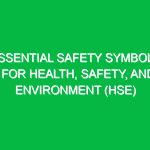Introduction
Hello team! Today, we’re going to have an important toolbox talk about a topic that affects all of us: fatigue. It’s a common issue that can lead to serious Safety risks if not properly managed. By the end of our discussion, you will understand the implications of fatigue in the workplace and how to combat it, ensuring both your Safety and the safety of your coworkers.
Understanding Fatigue
Before we dive into strategies for managing fatigue, let’s define what it is. In the context of Health, Safety, and Environment (HSE), fatigue refers to a state of physical and/or mental exhaustion that can impair an individual’s ability to perform tasks safely and effectively. It can stem from long working hours, inadequate rest, physical exertion, stress, and even personal life challenges.
Types of Fatigue
Fatigue can manifest in various forms, including:
- Physical Fatigue: This occurs after prolonged physical activity or when the body is not adequately rested.
- Mental Fatigue: Often results from prolonged cognitive activity, leading to decreased focus and decision-making ability.
- Emotional Fatigue: This can arise from stress, emotional labor, or personal issues, impacting motivation and mood.
Why Does Fatigue Matter in the Workplace?
Understanding the significance of fatigue is crucial for maintaining a safe working environment. Here are a few reasons why:
- Increased Risk of Accidents: Fatigue can lead to slower reaction times and impaired judgment, increasing the likelihood of accidents.
- Decreased Productivity: When workers are fatigued, their performance diminishes, which can affect overall productivity.
- Health Issues: Chronic fatigue can lead to severe health problems, such as cardiovascular disease, depression, and anxiety.
Recognizing Fatigue in Yourself and Others
It’s important to be aware of the signs of fatigue, both in ourselves and our coworkers. Common symptoms include:
- Difficulty concentrating or staying focused.
- Increased irritability or mood swings.
- Frequent yawning or feeling drowsy.
- Slower than usual reaction times.
- Taking longer to complete tasks than normal.
If you notice these signs in yourself or others, it’s crucial to address them immediately. Ignoring fatigue can lead to dangerous situations on the job.
Combatting Fatigue: Practical Tips
Now that we understand what fatigue is and why it’s important, let’s discuss some practical strategies to combat it.
1. Prioritize Sleep
Getting quality sleep is the most effective way to combat fatigue. Aim for 7 to 9 hours of sleep per night. Establish a regular sleep schedule by going to bed and waking up at the same time each day, even on weekends. Avoid caffeine and electronic devices in the hours leading up to bedtime.
2. Take Regular Breaks
During work hours, it’s essential to take regular breaks. Short breaks can help refresh your mind and body. Consider the “20-20-20” rule: every 20 minutes, look at something 20 feet away for 20 seconds. This helps reduce eye strain and mental fatigue.
3. Stay Hydrated and Eat Well
Nutrition plays a significant role in managing fatigue. Drink plenty of water and eat balanced meals that include fruits, vegetables, whole grains, and lean proteins. Avoid heavy meals that can make you feel sluggish.
4. Manage Stress
High levels of stress can contribute to fatigue. Engage in stress-relief activities such as mindfulness, meditation, or exercise. Even a short walk can help clear your mind and boost your energy levels.
5. Communicate Openly
If you’re feeling fatigued, don’t hesitate to talk to your supervisor. Open communication is vital for addressing workload issues or finding temporary solutions, such as adjusting schedules or redistributing tasks.
Real-Life Example: Fatigue in Action
Let’s consider a hypothetical scenario. Imagine a construction site where workers are required to operate heavy machinery after a long night shift with little sleep. One worker, John, is experiencing severe fatigue but feels pressured to continue. Due to his impaired judgment, he miscalculates a maneuver, resulting in a near-miss accident.
This situation highlights the importance of addressing fatigue proactively. Had John communicated his fatigue to his supervisor, adjustments could have been made to ensure safety.
Potential Hazards Associated with Fatigue
Fatigue can lead to various Hazards in the workplace, including:
- Increased likelihood of errors: Fatigue impairs concentration, leading to mistakes that can cause accidents.
- Impaired physical performance: Fatigued workers may struggle with physical tasks, increasing the risk of injury.
- Reduced situational awareness: A fatigued worker may be less aware of their surroundings, leading to unsafe conditions.
Recognizing these hazards and implementing measures to combat fatigue can significantly enhance Workplace Safety.
Regulations and Standards
In many industries, there are Regulations and standards pertaining to working hours and rest periods to combat fatigue. For example, the Occupational Safety and Health Administration (OSHA) emphasizes the importance of managing fatigue in the workplace. Companies are encouraged to develop policies that promote regular breaks and limit excessive overtime.
Compliance with these regulations not only enhances safety but also protects the organization legally. Ensuring that all employees are aware of these standards is a shared responsibility.
Conclusion
In closing, combating fatigue is essential for ensuring safety in our workplace. By prioritizing sleep, taking breaks, maintaining proper nutrition, managing stress, and communicating openly, we can all contribute to a safer working environment. Remember, it’s not just about your safety; it’s about the safety of everyone around you.
Thank you all for your attention and your commitment to safety. Let’s work together to combat fatigue and keep our workplace safe. Do you have any questions or thoughts on how we can better manage fatigue as a team?


